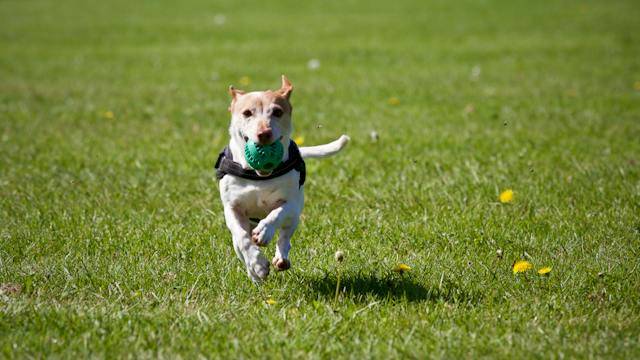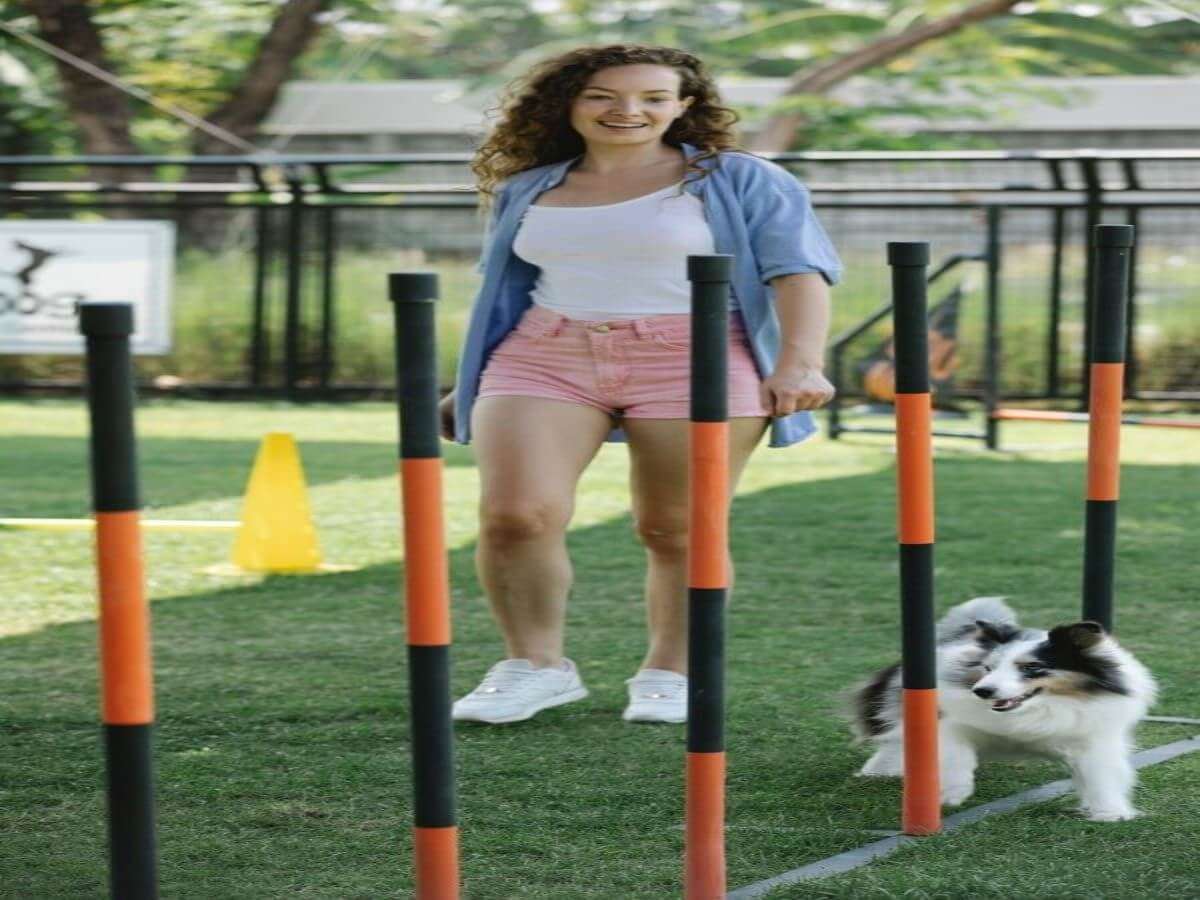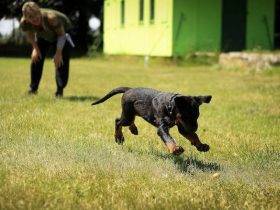Choosing the Right Dog Training Option for You
Whether you’ve just adopted your first dog or are looking to improve your skills with an existing canine companion, it’s important to research the various dog training options available to ensure you select the best fit. While all training seeks to establish important commands and behaviors, methods can differ greatly. This guide will explore some of the major approaches like group classes, private lessons, and board-and-train programs to help you find the right match based on your dog’s needs, schedule, and learning style.
Group Dog Training Classes
Group classes are one of the most popular and affordable ways to get started with basic obedience training. These sessions allow both you and your dog to learn and practice skills together in a structured classroom environment. Having other dogs present can also help with socialization. Here are some key things to know about group classes:
- Cost: Expect to pay around $100-$200 for a 6-8 week session held once or twice a week. Pricing may vary by location and trainer.
- Class size: Look for small groups of no more than 6 dogs to allow for individual attention. Larger classes make it difficult for trainers to effectively gauge each pet’s progress.
- Skills covered: Beginner classes focus on basic commands like sit, stay, come, and loose-leash walking. More advanced levels build on these and tackle issues like distraction-proofing.
- Group dynamics: While beneficial for some, the energy and distractibility of other dogs isn’t ideal for all pups. Shy, anxious or easily overstimulated breeds may struggle.
- Scheduling: Classes are held on set dates/times which work for busy owners but aren’t as flexible as private lessons if you need to miss a session.
If your dog is social, attention-seeking and motivated by treats/toys, group classes provide a fun, low pressure way to start training. But individual dogs and trainers vary, so take advantage of a trial session if possible before committing. Look for a dog trainer with experience handling reactivity issues should any arise in class.
Private Dog Lessons
Private lessons offer a more customized, one-on-one dog training approach without other dogs present as a distraction. This training method is particularly well-suited for:
- Reactive or aggressive dogs needing to build confidence without over stimulation from classes.
- Puppies too young for vaccines to be around other dogs yet.
- Senior or special needs dogs who cannot safely manage a traditional group setting.
- Owners wanting to make accelerated progress on advanced behaviors like obedience competition or service work.
Here’s what to expect with private training:
- Cost: Typically $50-$100 per hour session, with multiple sessions often recommended over 6-8 weeks.
- Size: Just you and your trainer with no other students or dogs present during the lesson.
- Pace: Training can progress more quickly since the trainer’s full focus is on your individual pup without dividing attention.
- Flexibility: Lessons are scheduled at your convenience instead of set class times. Rebook easily if you need to cancel or reschedule.
- One-on-one feedback: Trainers can provide detailed guidance, feedback and corrections tailored specifically to your dog’s body language and needs.
For dogs that struggle in groups due to sensitivity issues or those needing an accelerated training plan, private lessons deliver extremely effective results. They do come at a higher price point though, so group classes may still be a better starting point for most social, mentally sound pups.
Board-and-Train Programs for dogs
Another professional dog training approach is to board your dog for a period of 1-4 weeks while an experienced trainer works with them full-time. These dog intensive, immersion-style programs can yield dramatic results rapidly but also come with some key factors to weigh:
- Cost: Expect to pay $1000-$3000 on average depending on duration, location and specific services.
- Distance from dog: You are separated from your pet entirely for the training period. This isn’t recommended for newly adopted dogs still bonding with their owners.
- Training style: Some board-and-train facilities use harsh corrections that may cause psychological stress. Research the trainer’s methods thoroughly before leaving your dog in their care.
- Transition challenges: While obedience is established, you still need to maintain the training at home afterward, which can cause setbacks without owner education.
- Boarding stress: The unfamiliar environment and separation from family could negatively impact anxiety-prone dogs rather than helping their behavior.
Boarding programs may accelerate progress and resolve intensive issues like aggression with round-the-clock attention. But the lack of owner involvement also means lost opportunities for bonding and greater potential for new anxieties to develop post-training if not properly supported at home. So this option is best reserved for extremely challenging cases.
Online and Video Dog Training
Technology has expanded dog training access with online video courses and live stream classes offered from the comfort of your own home environment. While less personalized than in-person instruction, these digital formats provide budget-friendly options to fit various schedules:
- Cost: Most online subscriptions or video bundles range from $50-$200, comparable or less than group training classes.
- No travel: Eliminates commute time and expenses for both owners and trainers.
- Flexibility: Lessons can fit into your daily routine on your own schedule instead of rigid class times.
- Hands-on help: Many trainers offer live chat/video call support as needed for guidance practicing skills.
- Integrated resources: Courses include full libraries of tutorial videos covering techniques in depth.
The top benefit is convenience. However, online training lacks the tangible reinforcement of an instructor physically correcting techniques and observing body language cues in the moment. It may also be harder for shy owners or less motivated dogs to stay fully engaged without in-person accountability. Combining online courses with occasional private sessions delivers the best of both options.
Choosing a Trainer and Facility
Now that you understand the major training styles, selecting an accredited dog trainer is key. Here are some tips for vetting the right dog training programs and instructors:
- Certification: Look for CPDT-KA (Certified Professional Dog Trainer-Knowledge Assessed) accreditation through the CPDTI.
- Philosophy: Trainers should use positive reinforcement and avoid punishment-based techniques like choking, yelling or shock/prong collars.
- Experience: 5+ years working professionally with dogs in obedience, behavior modification and your pet’s particular issues.
- Facilities: Clean, well-ventilated indoor spaces and pleasant outdoor areas at training locations.
- Trial period: Reputable trainers offer evaluations and sample lessons to ensure your pup feels comfortable before committing.
- Communication: Ask about availability by phone/email for ongoing advice after your formal training ends.
- Reviews: Check online ratings plus first-hand recommendations from vet offices and local shelters.
With the right trainer-dog match, any of these training styles can reap wonderful results. Consider your budget, schedule flexibility and individual canine’s temperament when making the selection. Most importantly, keep an open line of trust with your chosen instructor every step of the training process.
Making Training Stick At Home
While professional guidance establishes new habits, long-term success relies on consistent home practice after formal lessons conclude. Owners should commit to:
- Daily 15-30 minute sessions continuing to reinforce learned skills through play, praise and treats.
- Generalizing across environments by practicing in different areas of your home and yard, then out in public once proofed.
- Addressing lapses calmly without yelling before they regress into old behaviors again.
- Attending periodic tune-up classes as maintenance to address emerging issues early before escalating.
- Using the same clear commands and signals consistently between all family members and guests.
- Exposing the dog to potential trigger situations or distractions very gradually with positive training.
- Consulting the trainer as needed for guidance or private sessions should challenges arise post-course.
With dedication and patience, you can help your dog maintain lifetime good habits through responsible ownership following professional guidance. Their training is an ongoing investment towards a well-behaved canine companion you’ll enjoy for many happy years together.
In conclusion, dog training is key to establishing a respectful relationship and ensuring safety for both pets and owners alike. While any certified program can help, choosing wisely involves considering the individual dog’s personality and your ability to commit different levels of time, travel and funds to mental and physical practice between lessons at home. With diligent research and the right trainer partnership, one of these methods should fit your needs for long-term success.





Leave a Reply